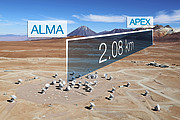Announcement
ALMA Performs Its First Very Long Baseline Observations
5 March 2015
ALMA, the Atacama Large Millimeter/submillimeter Array, has successfully combined its immense collecting area and sensitivity with that of APEX (Atacama Pathfinder Experiment) to create a new, single instrument through a process known as Very Long Baseline Interferometry (VLBI).
Larger telescopes can make sharper observations, and interferometry allows multiple telescopes to act like a single telescope as large as the separation — or baseline — between them. In VLBI, data from two independent telescopes are combined to form a virtual telescope that spans the geographic distance between them — potentially up to the diameter of the Earth — yielding extraordinary magnifying power.
An essential intermediate step is to test the technique on a short baseline. On 13 January 2015 ALMA and the nearby APEX telescope simultaneously studied the quasar 0522-364. This distant galaxy was used for this first-of-its-kind observation due to its remarkable brightness at radio wavelengths.
To ensure the telescopes were in sync, ALMA used a newly installed and exquisitely precise atomic clock to time-code the data as it was collected. An accurate time is essential for VLBI because it enables data taken at different geographical locations on different telescopes to be precisely matched and accurately integrated. The analysis of the data, which was recently completed, confirmed that the system was working correctly and that the ALMA atomic clock is precise enough for VLBI.
This first successful observation using VLBI with ALMA used a baseline of 2.1 km, and was an essential proof-of-concept test for the planned Event Horizon Telescope, which eventually will include a global network of millimetre-wavelength telescopes. When fully assembled, the Event Horizon Telescope — with ALMA as the largest and most sensitive site — will form an Earth-size telescope with the magnifying power required to see details at the edge of the supermassive black hole at the centre of the Milky Way.
More Information
This most recent work was carried out by a team made up of members from the ALMA Phasing Project (APP), the Joint ALMA Observatory (JAO), the Smithsonian Astrophysical Observatory and the APEX telescope.
The Atacama Large Millimeter/submillimeter Array (ALMA), an international astronomy facility, is a partnership of ESO, the U.S. National Science Foundation (NSF) and the National Institutes of Natural Sciences (NINS) of Japan in cooperation with the Republic of Chile. ALMA is funded by ESO on behalf of its Member States, by NSF in cooperation with the National Research Council of Canada (NRC) and the National Science Council of Taiwan (NSC) and by NINS in cooperation with the Academia Sinica (AS) in Taiwan and the Korea Astronomy and Space Science Institute (KASI).
ALMA construction and operations are led by ESO on behalf of its Member States; by the National Radio Astronomy Observatory (NRAO), managed by Associated Universities, Inc. (AUI), on behalf of North America; and by the National Astronomical Observatory of Japan (NAOJ) on behalf of East Asia. The Joint ALMA Observatory (JAO) provides the unified leadership and management of the construction, commissioning and operation of ALMA.
APEX is a collaboration between the Max Planck Institute for Radio Astronomy (MPIfR, 50%), the Onsala Space Observatory (OSO, 23%), and ESO (27%). The telescope is operated by ESO.
Links
- Event Horizon Telescope
- ALMA Observatory website
- ALMA and Interferometry
- More about ALMA
- Photos of ALMA correlator
Contacts
Richard Hook
ESO Public Information Officer
Garching bei München, Germany
Tel: +49 89 3200 6655
Email: rhook@eso.org
Charles E. Blue
Public Information Officer
National Radio Astronomy Observatory
Tel: +1 434.296.0314
Cell: +1 202-236-6324
Email: cblue@nrao.edu
About the Announcement
| Id: | ann15015 |

